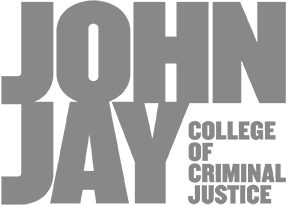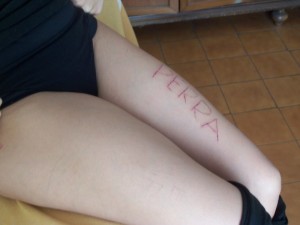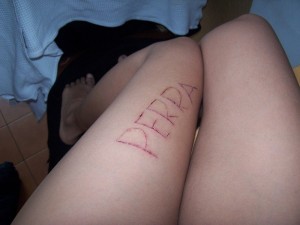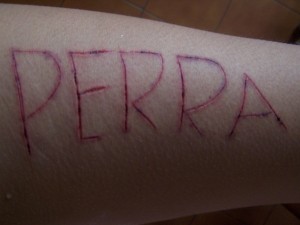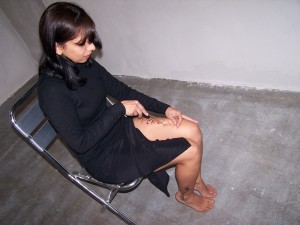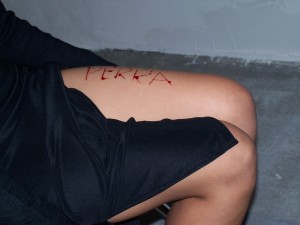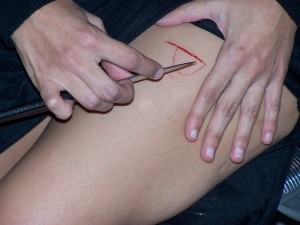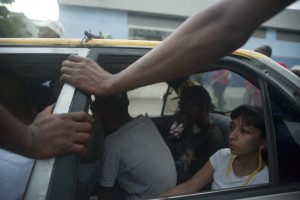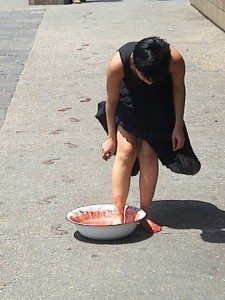Regina José Galindo was born in 1974 in Guatemala City, Guatemala where she currently lives and works. An internationally acclaimed visual artist specializing in performance art, Galindo is known for pushing her body to the limit to create powerful public works that challenge the inequalities and atrocities that have become commonplace across the globe. Her work has been widely exhibited in solo and group exhibitions including Estoy Viva at Padiglione d’Arte Contemporanea, Milan, Italy; the 49th, 51st, 53rd, and 54th Venice Biennale, Venice, Italy; the Moscow Bienniale; the Museum of Contemporary Art and Design, San José, Costa Rica; the Canary Islands Biennial, Canary Islands, Spain; the Festival of Corporeal Art, Caracas, Venezuela; the Museum of Latin American Art, Long Beach, CA, U.S.; and at the Tate Modern, London, U.K.
Galindo is the recipient of many prestigious awards and honors, including the Golden Lion for the best artist under 35 years old from the 51st Venice Biennale (2005), the Prince Claus Award from the Netherlands (2011), and the Grand Prize at the 29th Ljubljana Biennial of Graphic Arts in Ljubljana, Slovenia (2011). She has been selected for international artist residency programs including at the Chateau Trebesice, Prague, Czech Republic; Le Plateau, Paris, France; and Artpace, San Antonio, TX, U.S. Galindo’s work is included in numerous important collections, such as the Centre Georges Pompidou, Paris, France; the Solomon R. Guggenheim Museum, New York, NY, U.S.; the Castello di Rivoli – Museum of Contemporary Art, Turin, Italy, the Daros Latinamerica Collection, Zurich, Switzerland; the Blanton Museum of Art, Austin, TX, U.S.; the Museum of Contemporary Art, San José, Costa Rica; and the Pérez Art Museum Miami and Cisneros Fontanals Collection, both in Miami, FL, U.S.
Galindo is also an accomplished poet, receiving the 1998 Unique Prize for Poetry by the Myrna Mack Foundation. Her work has appeared widely in anthologies and magazines and in 1996 the Coloquia Foundation published her book Personal e intransmisible.
¿Quien Puede Borrar las Huellas? (Who Can Erase the Traces?) 2003
Video 37” 30’
Photo of the video-performance by José Osorio
Courtesy of the artist
Amnesty and Justice for All: The Art of Regina José Galindo
PERFORMANCE ARTISTS such as Marina Abramović currently enjoy a particular cachet in the art world. In Latin America however, a much more politicized version of performance has a long-standing presence as a platform for denouncing social injustice. There is a reason for this: sometimes the body can tell a story better than text. That may seem too simplistic an assertion, but it is an idea worth elaborating.
Consider the work by Regina José Galindo, No perdemos nada con nacer (We don’t lose anything by being born) (2000). The photographic documentation of this performance depicts a municipal garbage dump in Guatemala City and is much like other images of garbage dumps: sanitation workers stand around mounds of debris, about to sort the organic from the inorganic and the electronic. Heaps of plastic overwhelm the landscape. Front and center, a larger clear plastic bag catches your eye, and in it a body, crouching and immobile, in fetal position. You assume it is a dead body and wonder what it is doing there. The incongruence of the situation is normalized by the banality of the workers’ reaction to it, or rather the lack thereof. Just another body, just another victim.
The body belongs to the artist Galindo herself, a leading voice in a version of contemporary art committed to cultivating a visceral, indelible response in the viewer, one that lingers long after viewing the work. The violence to which she is responding, whether from gangs or the police, has been woven into the fabric of everyday life, making discarded bodies as common as other waste items.
Galindo’s performance, sedated and motionless in the plastic bag, lasted for two hours. The resulting video and photographic documentation, among the most reproduced from her body of work, has captivated audiences around the world. The passive body, fragile but resistant, was already a cornerstone of her earliest work as a performance artist, El dolor en un pañuelo (The Pain in a Handkerchief) from 1999.
Galindo, nude, is blindfolded with her hands and feet tied to the bed’s posts, as newspaper articles chronicling violence to women are projected onto her body. In her stillness, she becomes a canvas absorbing and reflecting the media headlines narrating revolting atrocities perpetrated on women in Guatemala, among them assassinations and rape, a country where a resounding majority of homicides go unsolved. In her (279) golpes ([279] Blows) from 2005, Galindo adopts a less passive role by enclosing herself in a cubicle where she cannot be seen, and in which she proceeds to strike herself 279 times, once for every woman assassinated in Guatemala in a brief six-month period between January 1 and June 9, 2005. She calls this work a “sound performance”; what the audience can hear is the amplified sound of the strikes, growing in intensity as her body once again becomes the tableau for absorbing and reflecting the violence suffered by others. The noise of the strikes weighs all the heavier on the viewer, who knows but cannot see their source.
Galindo’s artistic preoccupations are inextricably tied to Guatemala, her country of birth and context of inspiration. It was the seat of one of Latin America’s most violent civil wars, which lasted three long decades and only officially ended with the signing of a peace accord in 1996. The brutality of the war is astounding, including the deaths of 200,000 people, 83 percent of whom were of Mayan descent, and many others were detained, disappeared, tortured, and raped. Despite a United Nations report, which found that the overwhelming majority of the human rights violations were carried out by the military, there have been few trials to seek justice. Instead, the regime’s officials were granted amnesty upon the signing of the peace accord. Those affected by the violence have yet to see any recognition of guilt by the perpetrators, even though evidence is plentiful as mass graves are found and countless bodies exhumed. Today, the violent grip that the civil war had on the country has by no means been resolved and has instead resulted in a lasting legacy of corruption and state violence.
In spite of the connective tissue between Galindo’s art and its context, there is a universal appeal to the poetry of her artistic actions. (It should be noted that she was a poet before she became an artist and regularly writes poetry.) Her work has been included in countless exhibitions and biennials worldwide, including Ljubljana, Lima, Sydney, Venice, Prague, Moscow, and Valencia, to name only a few. Among the first work to bring her to international prominence was Piel (Skin) (2001), performed at the 49th Venice Biennale, which was aptly titled Plateau of Humankind by its organizer, Harald Szeemann, a legendary curator (whose archive was recently acquired by the Getty Research Institute). Szeemann traveled to Central America by way of an invitation from the contemporary art space TEOR/éTica in San José, Costa Rica, where he met Galindo and saw El dolor en un pañuelo. He later included several Central American artists whose work he encountered in the coveted Venice Biennale.
Galindo prepared for Piel in front of an art-hungry audience, who watched her as she meticulously shaved all the hair off her body. Starting with her head, then her pubic and armpit hair, she efficiently eliminated all immediate markers of her femininity. She then disrobed, revealing a slender, boyish frame, and left the space of the Biennale to walk through the city and along the canals in the nude, soliciting questioning stares from passersby during her 90-minute walk. The female nude is no stranger in Venice, where the 16th-century painter Titian created the archetype for idealized female nudity with his Venus of Urbino. But when asked about the work, Galindo did not invoke the city’s past artistic heritage and said instead that she was aiming to address her own fears as a woman from a third-world country hoisted to prominence by the stage of contemporary art. She decided to embrace and display her vulnerability, a constant in her practice.
If Piel primed Galindo to step into (and out of) the contemporary art world, then a later iteration of walking through the city took on a decidedly more eerie tone in ¿Quién puede borrar las huellas? (Who Can Erase the Traces?), an especially haunting performance from 2003, which took place in Guatemala City. For this performance, the artist arrived at the site of the Constitutional Court, a governing body composed of five judges who oversee Guatemala’s constitution. She wore a simple black dress, a symbol of mourning, and walked barefoot, holding a large white bowl filled with fresh human blood, which she purchased from a medical laboratory. She walked, carrying the bowl of blood, stopping every few steps and dipping her feet before continuing to walk, thus leaving fresh, bloody footprints in her path. She completed the performance at the stairs of the National Palace, a good half-an-hour distance away, leaving the soldiers protecting the palace to stare questioningly at the bowl of human blood. As the surrounding public watched the artist’s body insert itself into these contested public spaces, there was no question that Galindo refreshed the traces of the bloody past.
It is no coincidence that ¿Quién puede borrar las huellas? took place in 2003: Galindo has repeatedly explained that she was denouncing the 2003 presidential campaign of former president José Efraín Ríos Montt, and the idea that “Guatemala is a country without memory.” A highly controversial figure, Ríos Montt and his military regime were responsible for much of the genocide of Guatemala’s indigenous populations. He was formally charged in 1999 by Rigoberta Menchú, the country’s renowned Nobel Peace Laureate, whose chilling account of the war in the autobiography I, Rigoberta Mechú(1983) captured the world’s attention. During the 1980s, at the height of such atrocities, the Reagan administration embraced and financially supported Ríos Montt, praising his leadership and integrity. Bill Clinton later acknowledged the gravity of this error in 1999 when he formally apologized for the United States’ role in the war. Ten years after Galindo’s Huellas, in 2013, Ríos Montt was once again brought to trial and finally charged for his role in the genocide, only to have the Constitutional Court overturn the conviction. There are few happy endings.
Galindo registers such indolence to the pursuit of justice in a work from 2000 entitled Valium 10ml — an action carried out during the Vivir Aquí (To Live Here) exhibit at the Museo Ixchel del Traje Indígena, a museum devoted to Guatemalan indigenous textiles. For the event, artists were asked to respond to the question, “What does it mean to live in a country like Guatemala?” Galindo responded by taking 10 ml of Valium and going to sleep.
Not all of Galindo’s work has strictly political references. One recurring theme is the interrogation of social norms and practices, particularly as they apply to women. Himenoplastia (2004) is a powerful case in point. For this work Galindo was filmed getting a hymenoplasty, a surgical reconstruction of the hymen. She explains the details surrounding this surgery to the writer Francisco Goldman in their enlightening 2006 published interview.[1]Galindo recounts that she was struck by ads in the newspaper publicizing the surgery, and chose to respond to one of the ads. She went to the stated doctor’s office, showed him her previous artwork, and asked to film him completing the procedure on her as a performance, a request he conceded to after payment. To say that the video documentation is nerve-racking to watch is an understatement. Having recently watched audience reactions to this work at Galindo’s artist lecture at the University of Utah, I found that this particular performance brings viewers to the threshold of visual tolerance.
Why, one speculates, would anyone do this to themselves; except that they do, and in droves. It is a surprisingly common procedure in Guatemala and other conservative countries where a woman is still expected to be a virgin until she gets married. Galindo also clarifies that the operation is carried out on young girls who are the victims of sex trafficking, since virgins are highly sought out and therefore yield more money in the trade. It is impossible not to wince while watching this footage. Even more terrifying is the fact that following the operation (which only lasted 30 minutes) the artist began to bleed profusely and had to be rushed to the hospital. The viewer is left wondering how many of these operations are botched? How many young girls are permanently damaged in the process? Galindo later showed this work at the 2005 Venice Biennale, and it won her the highly prized Golden Lion award for artists under 30.
Galindo revisited the question of elective plastic surgery, albeit in a more reserved way, in Recorte por la línea (Cut Along the Line) just a year later in 2005 during the first Body Art Festival in Caracas, Venezuela. For this event she visited one of Venezuela’s most sought out plastic surgeons, Billy Spence, and had him mark up her body by highlighting those areas that he felt would need to be perfected so as to have the ideal body according to Western standards of beauty. The resulting documentation of Galindo’s body entirely marked up in brightly colored pens is so ludicrous as to be comical, as if the doctor were creating a geometric abstract painting and not working on an actual human being. Incidentally, on Dr. Spence’s website, there is a video of him talking about his painting hobby and displaying what seems like hundreds of large canvases of bodies that he has painted. It is curious to think that both Galindo and the doctor each pursue their own artistic practices, so at odds with each other, through the same work.
While she has not often worked in the United States, Galindo was invited to be a resident artist at Artpace in San Antonio in the spring of 2008. During this time she became interested in questions surrounding immigration, a topic that is difficult to escape in the current political landscape and even more so for a Guatemalan living in Texas. One of the news stories that especially resonated with Galindo was the presence of the T. Don Hutto Family Residential Center located in Taylor, about an hour-and-a-half drive from San Antonio. Run by a for-profit corporation known as CCA (Corrections Corporation of America), the largest private prison and detention services company in the United States, the Center was formerly a medium-security prison. In 2006, T. Don Hutto, contracted by Immigration and Customs Enforcement, opened as a holding facility for families awaiting immigration proceedings, a process that can take up to a year. It was the first facility of its kind to detain whole families (including pregnant women, adolescents, children, and babies) while their status is determined; prior to this, people who had children and were awaiting immigration proceedings were given a date for their hearing and asked to show up. The name “Residential Center” is a euphemism at best, and the Center retained many of the attributes of a prison, where the inhabitants, including their innocent kids, lived in cold, cramped, cell-like rooms without sunlight, could not come and go at will, and had their daily activities dictated to them: they were told when to eat, sleep, go outside, etc. For this service, T. Don Hutto was paid $200 per day/per family, a daunting sum considering what a hotel would cost. In 2007, the American Civil Liberties Union and the University of Texas School of Law Immigration Clinic brought a suit against the government for housing children in substandard conditions.
For her performance at Artpace, America’s Family Prison, Galindo used the payment from her residency, $8,000, to rent a cell (modeled on those of the Residential Center) from Sweeper Metal Fabricators Corp, a company in Oklahoma that makes both maximum- and minimum-security correctional facilities. Galindo had the fabricated cell transported to San Antonio and placed inside the gallery. She then inhabited the cell with her husband and their baby for 24 hours. Visitors to the gallery could glimpse inside the cell through a narrow window and peek at the family during their voluntary confinement. After 24 hours, the family left the space and the cell remained in the gallery for viewing. What is most disturbing about the images of this performance is seeing her baby in detention. In a documentary chronicling the case of T. Don Hutto, The Least of These: Family Detention in America(2009), the most painful scenes to watch involve the kids and the trauma this experience provoked for them. One young girl recalls her time in the Center with horror, stating that during her entire time there she had constant nightmares that the police would come and take her mother away. She says this repeatedly.
In response to the 2007 suit, the Department of Homeland Security stopped sending families to T. Don Hutto in 2009, a successful instance of community activism and advocacy efforts. However, in 2014, the Department of Homeland Security reopened the issue in response to the unprecedented number of minors crossing the border. What is important about Galindo’s performance of the detention center in an art gallery setting is that it cultivated a different framework for considering the question of immigration. It is beyond the scope of this text to go into the details of this complicated albeit pressing topic, but one of the problems in criminalizing immigrants through, among other things, these detention centers, is that it robs them of the unique circumstances that led them to make the treacherous border crossing in the first place. Those who follow the media’s coverage of immigration debates get inured to the individual family stories, which get subsumed by the political controversies.
Galindo, while not directly affected by immigration policy, is no stranger to it. During the 30-year civil war, hundreds of thousands of Guatemalans sought refuge in Mexico and the United States, and today, gang and drug violence force thousands of others to brave the difficult journey al norte. More than 30 years ago, this was the premise of Gregory Nava’s well-known film, El Norte (1983), about Mayan peasants in Guatemala who flee the war at great risk to make their way to Los Angeles after their village is destroyed and its inhabitants massacred by the army. In today’s political debates, the media depicts immigrants as a homogenous entity; those coming from Mexico or from other countries in Central American, including Guatemala, are thought of interchangeably, and the conditions of their individual plights are replaced by standoffs in Congress between conservative and liberal agendas. This is where art, and particularly performance art, can step in and shift things around. An individual body, with a unique identity and story, disturbs totalizing media depictions. When text can deceive or be ignored, a body provokes in a physical and emotional way.
Galindo has been pursuing this corner of the art world for the past 15 years, and she will no doubt continue to do so. In her artist lectures, she has said that she does not just portray the victim, but instead seeks to reveal the relationship between the victim, the victimizer, and the institutional structures (the State, the military, religion, patriarchy) that promote abuses of power. Oftentimes, she admits, the victimizers are also victims of the institutional structure. But this is harder to accept when reading a text, and is more intuitive when watching one of Galindo’s performances, in which her body declaims through silence, activates through passivity, and strengthens through vulnerability. She is by no means alone. In Guatemala there is not only a long, historic legacy of artistic production, but also an active contemporary art scene. Across other countries in Central America, artists have developed powerful ways to insert their bodies where their voices are otherwise silenced by violence, by the politicians, and by the media.
[1] See http://bombmagazine.org/article/2780/regina-jos-galindo
